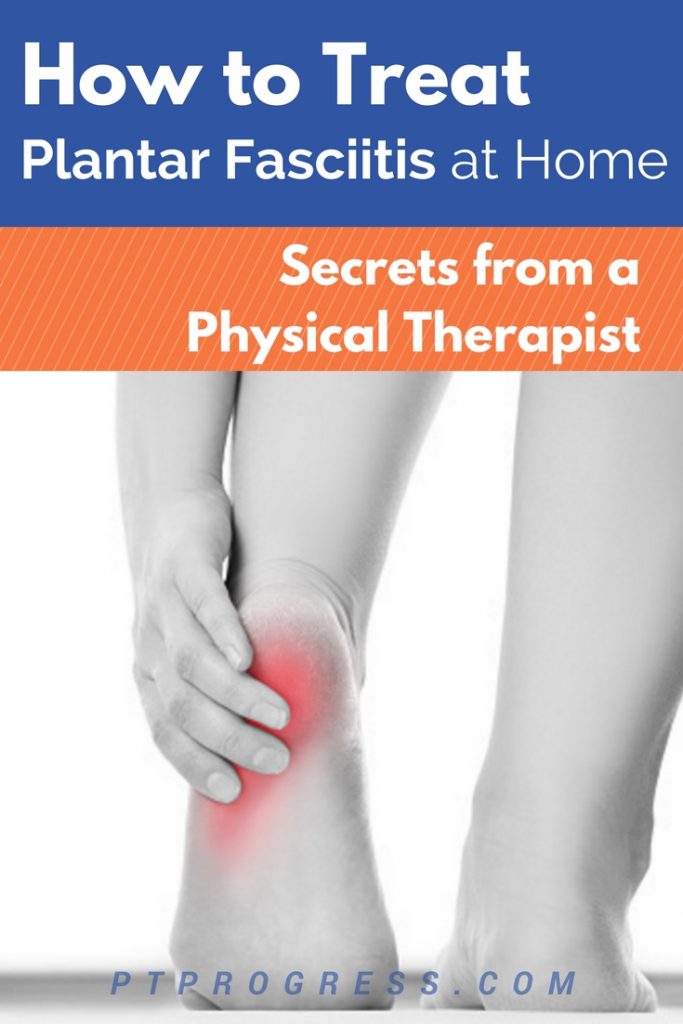
In my experience as a PT specializing in orthopedic injuries such as plantar fasciitis, I’ve seen the most success with the treatment of heel pain when people establish a routine and make a conscientious effort to change habits.
How to Treat Plantar Fasciitis at Home
Modify Your Walking
Plantar fasciitis is frustrating, no question about that! I’ve personally dealt with and resolved plantar fasciitis through self-treatment. Part of self-treatment involves identifying activities or habits that may be causing the heel pain or preventing you from fully healing. Here are 3 of the most common habits I see among my patients suffering from plantar fasciitis.
Identifying 3 Key Faults of Walking
As part of the walking analysis I perform with everyone, I watch for a few key items: gait speed, hip rotation, and pushoff pattern.
Gait Speed: Gait (or walking) speed is difficult to change, especially for those who are fast walkers. The issue with walking fast is that it usually leads to increased hip rotation, which we’ll cover next. If you are suffering from heel pain and continue to walk fast, you are setting yourself up for continued pain. Slow your walk and you’ll start to control the mechanics of your walking pattern.
Increased Hip rotation: Speaking of your walking pattern, if you put your hands on your hips while walking, can you feel a rotation in your hips? It’s normal to have some rotation, but when you have pain in your foot, ankle or knee, it’s common to see excessive rotation as compensation. Focus on keeping your hips from rotating as much and you’ll be addressing one of the biggest movement faults I see with walking.
Poor Push off Patterning: When you make contact with your foot and the ground, do you notice any difference between your painful foot and your other side? Do you avoid pushing off with your toes? Do you actually walk on your toes? This will lead to nothing but problems and continued heel pain. Try to modify your walking by slowing your speed, controlling your rotation, and to think about walking in a ‘heel to toe’ pattern. This will slow your walking down a bit, but will encourage improved patterning and better gait mechanics as you practice.
Create a Routine
The solution for most people I treat often comes through multiple factors. Rarely is there a ‘quick fix’ for PF. Identifying areas of weakness in the foot and ankle, resolving tightness and addressing walking pattern substitutions is an important piece of the puzzle.
Of course, strengthening the right muscles and improving your flexibility takes weeks. You need to be consistent and find a way to regularly perform your stretches and exercises.
My most successful patients establish a routine with their exercises. They understand the importance of consistency and make it a regular part of their day.
My least successful patients make excuses and continue to have pain.
Ask your Doctor about Antiinflammatory solutions
As a PT, it’s out of my scope of practice to recommend medication. But if you understand the inflammatory response caused by plantar fasciitis, it would make sense to ask your doctor about taking ibuprofen or another anti-inflammatory solution to manage the heel pain.
Use Proper Foot Support
My first line of defense with plantar fasciitis is to teach my patients how to use their own muscles, the intrinsic muscles of the foot to support their foot.
Many of them have tried foot supports already and are hesitant to try any more arch supports for plantar fasciitis.
Often I’m asked about the best shoes and inserts for plantar fasciitis. My answer is usually fairly consistent with these 3 points:
1. Find a shoe that is comfortable. This is your best indicator of the ‘right’ shoe for you. If the footwear is uncomfortable, don’t wear it.
2. Ease into new footwear gradually. Start by wearing your new supportive shoes inside your house for 30 to 60 minutes every day for a week before you actually wear them for an entire day. Your feet may need some time to adjust so gradually introduce new shoes in a controlled environment.
3. Orthotics can be helpful in the short term, but continue to do your exercises. This obviously leads to the next question: which orthotic should I get? I have personally recommended and wear the TreadLabs insole. This is an over the counter insert that provides correction to alignment issues many people have. Often times, correcting the alignment of the lower extremities can reduce or eliminate back, hip, and knee pain. You can read my full TreadLabs review here.
Extra Tip: If your plantar fasciitis is taking a while to resolve, there is research that recommends the use of night splints to promote improved positioning of the foot at night. A night splint will prevent the foot from pointing downward at night, a motion that tightens the calf muscle that inserts into the heel of your foot.
Do your Physical Therapy Exercises
Your PT can identify muscles that are weak, tight, too strong (compensating) and address balance and instability issues through exercises and stretches.
Create your routine and follow the home exercise plan they provide for you. Don’t have exercises? Take a look at these plantar fasciitis exercises to get started.


This is great! Thank you so much for your advice. I will start with your recommendations ASAP.
Is it harmful to go barefoot in the house with PF? a I hate slippers!